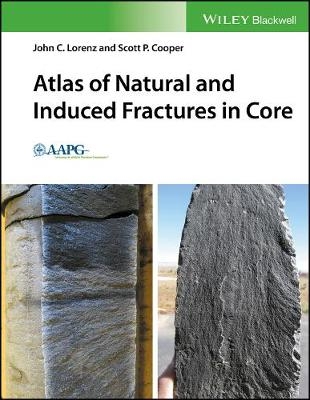
Atlas of Natural and Induced Fractures in Core
Wiley-Blackwell (Verlag)
978-1-119-16000-7 (ISBN)
- Titel z.Zt. nicht lieferbar
- Versandkostenfrei innerhalb Deutschlands
- Auch auf Rechnung
- Verfügbarkeit in der Filiale vor Ort prüfen
- Artikel merken
An invaluable reference that helps geologists recognize and differentiate the many types of natural fractures, induced fractures and artefacts found in cores
Atlas of Natural and Induced Fractures in Core offers a reference for the interpretation of natural and induced fractures in cores. The natural and induced fracture data contained in cores provides a wealth of information once they are recognized and properly interpreted. Written by two experts in the field, this resource provides a much-needed tool to help with the accurate interpretation of these cores.
The authorsinclude the information needed to identify different fracture types as well as the criteria for distinguishing between the types of fractures. The atlas shows how to recognize non-fracture artefacts in a core since many of them provide other types of useful information. In addition, the text’s illustrated structures combined with their basic interpretations are designed to be primary building blocks of a complete fracture assessment and analysis. The authors show how to recognize and correctly interpret these building blocks to ensure that subsequent analyses, interpretations, and modeling efforts regarding fracture-controlled reservoir permeability are valid.
Presented in full color throughout, this comprehensive reference is written for geologists charged with interpreting fracture-controlled permeability systems in reservoirs as well as for students or other scientists who need to develop the skills to accurately interpret the natural and induced fractures in cores.
John C. Lorenz and Scott P. Cooper are Senior Geologists with FractureStudies LLC in Edgewood, New Mexico.
Foreword xi
Preface xiii
Acknowledgments xv
Introduction 1
Part 1 Natural Fractures 9
Section A Extension Fractures 11
A1 High‐Angle Extension Fractures 13
A1a Introduction 13
A1b Fractography of High‐Angle Extension Fractures 14
A1c Extension Fracture Dimensions 21
A1d Extension Fracture Variations and Lithologic Influences 33
A1e High‐Angle Extension Fracture Intersections 43
A1f High‐ Angle Extension Fractures in Deviated Core 47
A2 Inclined Extension Fractures 51
A2a Inclined Extension Fractures in Horizontally Bedded Strata 51
A2b Inclined Extension Fractures in Inclined Strata 53
A2c Vertical Extension Fractures in Inclined Strata 54
A3 Horizontal Extension Fractures 55
A3a Beef‐Filled Fractures 55
A3b Other Calcite‐Mineralized Horizontal Extension Fractures 57
A3c NOT Horizontal Extension Fractures 57
Section B Shear Fractures 59
B1 Introduction 61
B1a Nomenclature 61
B1b Anderson’s Shear Fracture/Fault Classification 62
B2 Shear Fracture Dimensions 65
B3 Shear Fracture Fractography 67
B3a Slickensides, Slickenlines, and Accretionary Steps 67
B3b En Echelon Segments 69
B3c Steps 71
B3d Pinch and Swell 72
B3e Sheared and Glassy Surfaces 75
B3f Slickencrysts 75
B3g Other Evidence for Shear 76
B4 High‐Angle Shear Fractures 79
B4a Introduction 79
B4b High‐Angle Strike‐Slip Shear Fractures 79
B4c Non‐ Ideal High‐Angle Shear Fractures 82
B5 Intermediate‐Angle Shear Fractures 85
B6 Low‐Angle Shear Fractures 89
B7 Bed‐Parallel Shear Fractures 93
B8 Deformation Bands 97
B9 Faults 101
Section C Other Types of Natural Fractures 105
C1 Introduction 107
C2 Microfractures 109
C3 Ptygmatically Folded Fractures 111
C4 Fissures 117
C5 Veins 119
C6 Expulsion Structures 121
C7 Syn‐Sedimentary Fractures 125
C8 Compound/Reactivated Fractures 133
C9 Shattered Rock 137
C10 Karst Breccias 139
C11 Pocket‐Size Geomechanical Systems 143
C12 Stylolites 147
Section D Mineralization 151
D1 Mineralization 153
D1a Introduction 153
D1b Calcite Mineralization 154
D1c Other Types of Mineralization 160
D1d Oil and Bitumen 163
D1e False Mineralization 167
Part 2 Induced Fractures 171
2A Introduction 173
2B Petal and Saddle Fractures 175
2C Centerline Fractures 185
2D Disc Fractures 197
2E Scribe‐Knife Fractures 209
2F Torque and Helical Twist Fractures 213
2G Core‐Compression Fractures 219
2H Percussion‐Induced Fractures 221
2I Bending Fractures with Barbs 225
2J Irregular Crack Networks 229
2K Induced Fractures with Curved Strikes 233
2L Waterflood‐Related Fractures 237
2M Cored Hydraulic Fractures 241
Part 3 Artifacts 245
3A Introduction 247
3B Core Tops and Core Bases 249
3C1 Core‐Catcher Drag 253
3C2 Core Orientation Scribe Grooves 257
3C3 Irregular Core Diameters 261
3C4 Pinion Holes 263
3D1 Spinoffs 265
3D2 Twice‐Turned Core 269
3E Saw Scars 271
3F1 Core Plucking 277
3F2 Scratches 279
3F3 Drill‐Mud Erosion 281
3F4 Core‐Parting Enigmas 283
3F5 Polished Fracture Surfaces in Horizontal Cores 285
3F6 Tip Polish 287
3F7 Slab‐Plane Consistency 291
3F8 Illusions 295
3F9 Coring‐Related Rock Alteration on Core Surfaces 299
Index 301
| Erscheinungsdatum | 30.01.2018 |
|---|---|
| Verlagsort | Hoboken |
| Sprache | englisch |
| Maße | 221 x 282 mm |
| Gewicht | 1225 g |
| Themenwelt | Naturwissenschaften ► Geowissenschaften ► Geologie |
| Technik | |
| ISBN-10 | 1-119-16000-6 / 1119160006 |
| ISBN-13 | 978-1-119-16000-7 / 9781119160007 |
| Zustand | Neuware |
| Haben Sie eine Frage zum Produkt? |
aus dem Bereich


